Computer processor maker Intel (NASDAQ:INTC) reported results in line with analysts' expectations in Q1 CY2024, with revenue up 8.6% year on year to $12.72 billion. On the other hand, next quarter's revenue guidance of $13 billion was less impressive, coming in 4.4% below analysts' estimates. It made a non-GAAP profit of $0.10 per share, improving from its loss of $0.04 per share in the same quarter last year.
Intel (INTC) Q1 CY2024 Highlights:
- Revenue: $12.72 billion vs analyst estimates of $12.78 billion (small miss)
- EPS (non-GAAP): $0.10 vs analyst expectations of $0.14 (26.8% miss)
- Revenue Guidance for Q2 CY2024 is $13 billion at the midpoint, below analyst estimates of $13.59 billion
- EPS (non-GAAP) Guidance for Q2 CY2024 is $0.10 at the midpoint, below analyst estimates of $0.26
- Gross Margin (GAAP): 41%, up from 34.2% in the same quarter last year
- Inventory Days Outstanding: 139, up from 121 in the previous quarter
- Free Cash Flow was -$6.18 billion compared to -$1.31 billion in the previous quarter
- Market Capitalization: $146.9 billion
Inventor of the x86 processor that powered decades of technological innovation in PCs, data centers, and numerous other markets, Intel (NASDAQ: INTC) is the leading manufacturer of computer processors and graphics chips.
Founded in 1970 by Gordon Moore, Robert Noyce, and Andy Grove, Intel’s first business was actually focused on building memory chips,dynamic random-access memory (DRAM). The company had a near monopoly in the late 1970s, before Japanese competitors crushed Intel on pricing, prompting one the great pivots in tech history when it switched its focus to computer processors and was selected by IBM to provide the processor for the first PC in 1981. Intel’s x86 processor architecture subsequently became the industry standard for PCs, transforming the company into the dominant provider of chips used in PCs and data centers for decades.
Once revered for both its R&D and manufacturing prowess, Intel failed to diversify into growing end markets such as smartphones, 4G/LTE, and GPUs because it didn’t want to get into these (at the time) smaller and less profitable end markets - especially when it had a near monopoly in the highly profitable CPU business.
Over the past decade, Intel’s manufacturing edge first stagnated, and today trails rivals TSMC and Samsung, reducing its pricing power and margins. Intel faces ongoing challenges as its former x86 strongholds in PCs and datacenters are threatened by GPUs and ARM-based alternatives.
Intel's primary competitors are Advanced Micro Devices (NASDAQ:AMD) and Nvidia (NASDAQ:NVDA), and Qualcomm (NASDAQ:QCOM).Processors and Graphics Chips
Chips need to keep getting smaller in order to advance on Moore’s law, and that is proving increasingly more complicated and expensive to achieve with time. That has caused most digital chip makers to become “fabless” designers, rather than manufacturers, instead relying on contracted foundries like TSMC to manufacture their designs. This has benefitted the digital chip makers’ free cash flow margins, as exiting the manufacturing business has removed large cash expenses from their business models.
Sales Growth
Intel's revenue has been declining over the last three years, dropping by 9.5% on average per year. But as you can see below, this was a strong quarter for the company, with revenue growing from $11.72 billion in the same quarter last year to $12.72 billion. Semiconductors are a cyclical industry, and long-term investors should be prepared for periods of high growth followed by periods of revenue contractions (which can sometimes offer opportune times to buy).
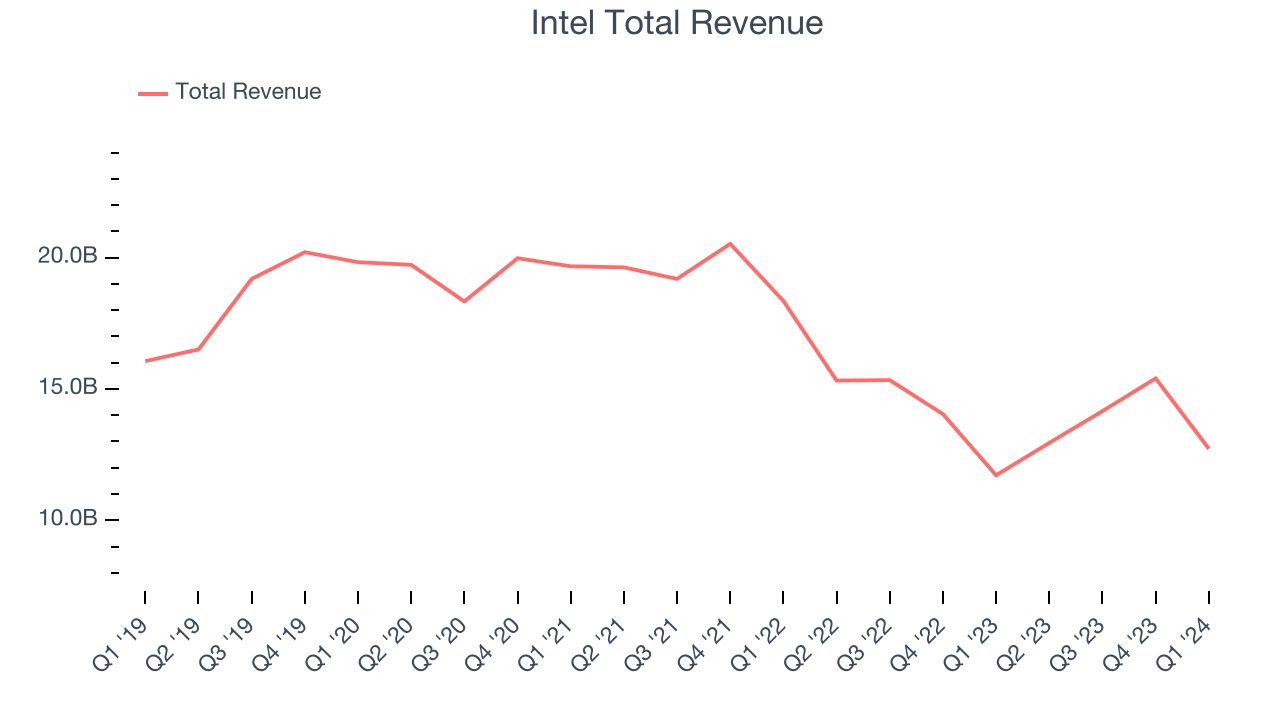
Intel had a slow quarter as its unremarkable 8.6% year-on-year revenue growth missed analysts' estimates by 0.4%. Despite these results, we believe Intel is still in the early days of an upcycle, as this was just the second consecutive quarter of growth and a typical upcycle tends to last 8-10 quarters.
Intel's management team believes its revenue growth will continue, guiding to 0.4% year-on-year growth next quarter. Analysts expect the company to grow its revenue by 7.9% over the next 12 months.
Product Demand & Outstanding Inventory
Days Inventory Outstanding (DIO) is an important metric for chipmakers, as it reflects a business' capital intensity and the cyclical nature of semiconductor supply and demand. In a tight supply environment, inventories tend to be stable, allowing chipmakers to exert pricing power. Steadily increasing DIO can be a warning sign that demand is weak, and if inventories continue to rise, the company may have to downsize production.
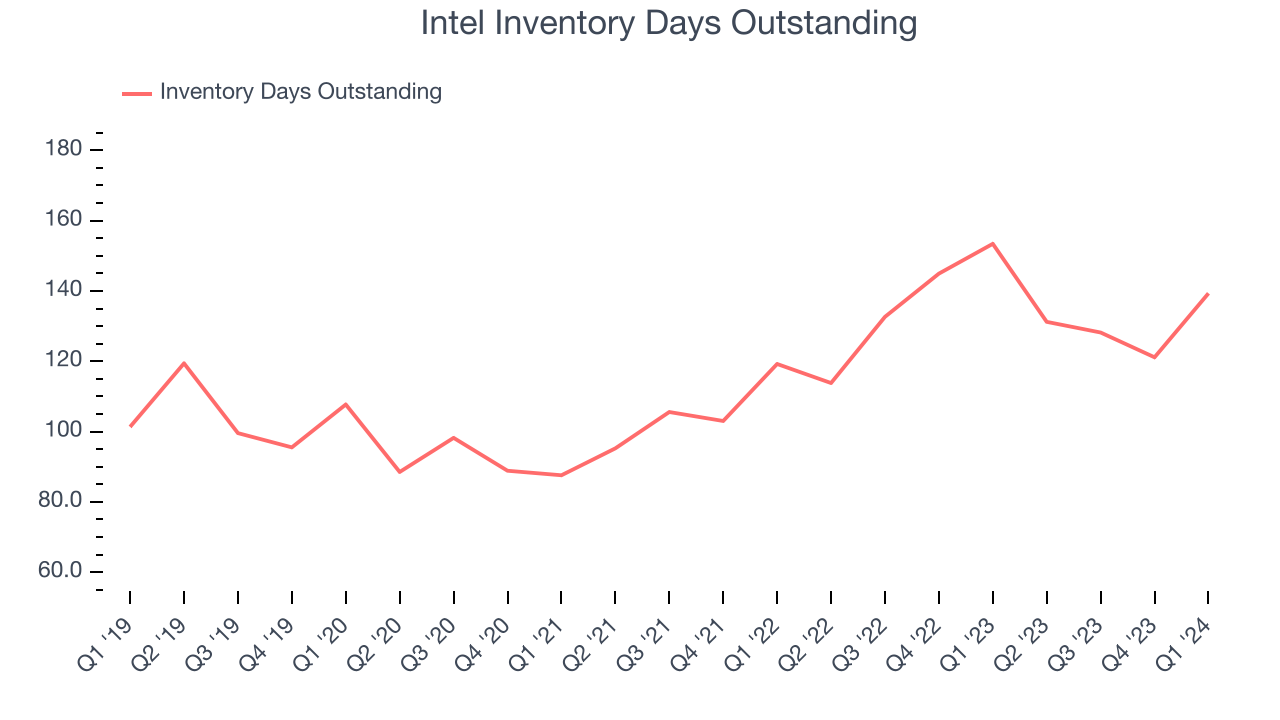
This quarter, Intel's DIO came in at 139, which is 26 days above its five-year average, suggesting that the company's inventory has grown to higher levels than we've seen in the past.
Pricing Power
In the semiconductor industry, a company's gross profit margin is a critical metric to track because it sheds light on its pricing power, complexity of products, and ability to procure raw materials, equipment, and labor. Intel's gross profit margin, which shows how much money the company gets to keep after paying key materials, input, and manufacturing costs, came in at 41% in Q1, up 6.8 percentage points year on year.
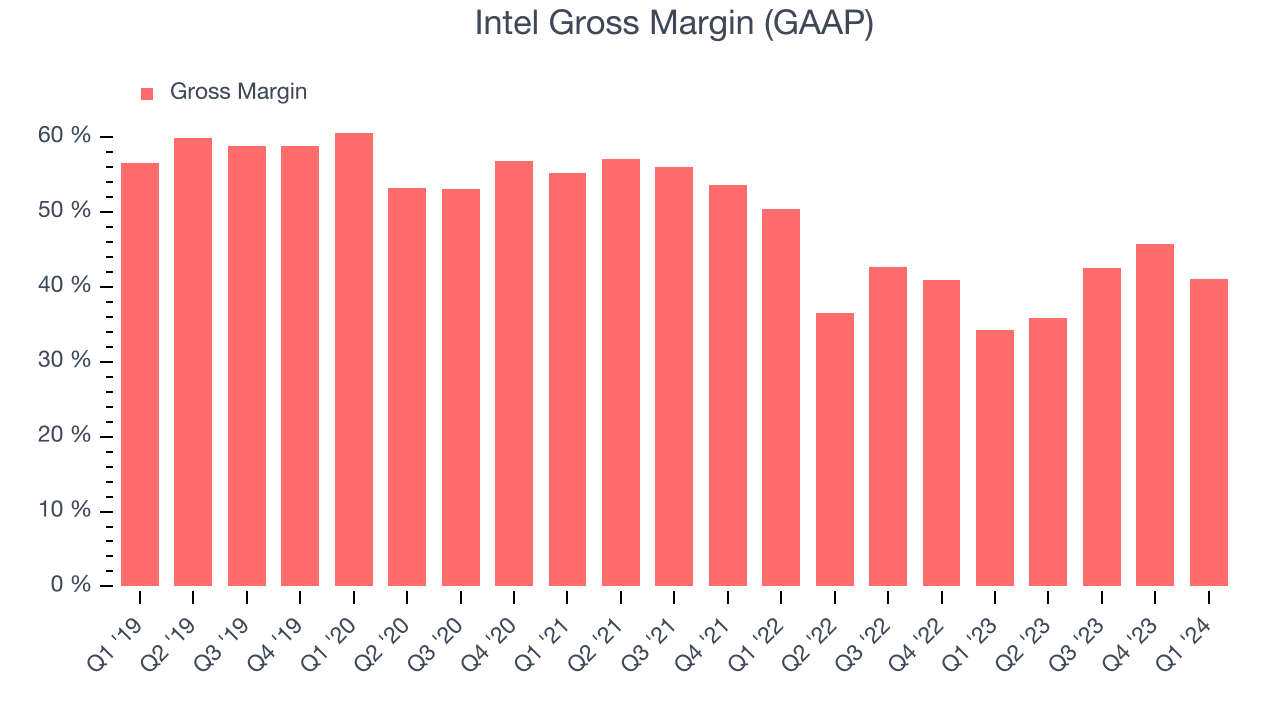
Intel's gross margins have been trending up over the last 12 months, averaging 41.5%. This is a welcome development, as Intel's margins are below the industry average, and rising margins could suggest improved demand and pricing power.
Profitability
Intel reported an operating margin of 5.7% in Q1, up 8.2 percentage points year on year. Operating margins are one of the best measures of profitability because they tell us how much money a company takes home after manufacturing its products, marketing and selling them, and, importantly, keeping them relevant through research and development.
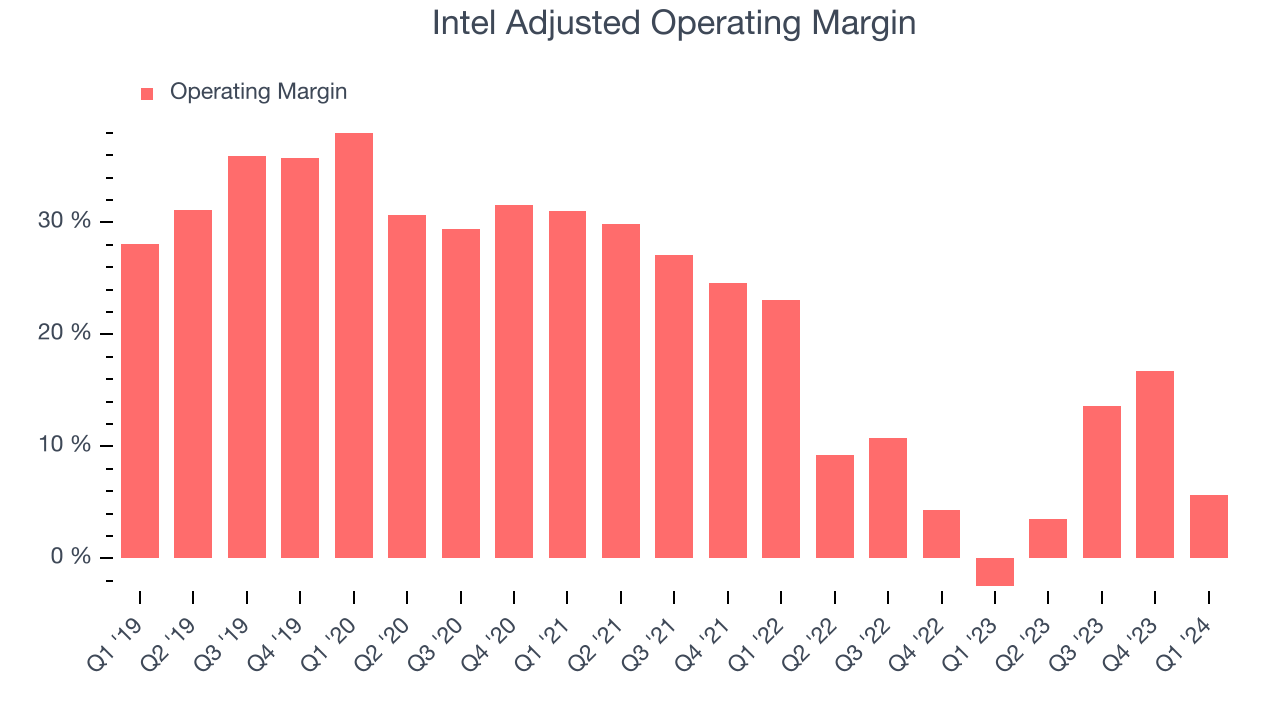
Intel's operating margins have been trending up over the last year, averaging 10.3%. This is a welcome development for Intel, whose cost structure isn't as efficient as it could be, as indicated by its slightly below-average margins.
Earnings, Cash & Competitive Moat
Analysts covering Intel expect earnings per share to grow 103% over the next 12 months, although estimates will likely change after earnings.
Although earnings are important, we believe cash is king because you can't use accounting profits to pay the bills. Intel's free cash flow came in at negative $6.18 billion in Q1, up 29.5% year on year.
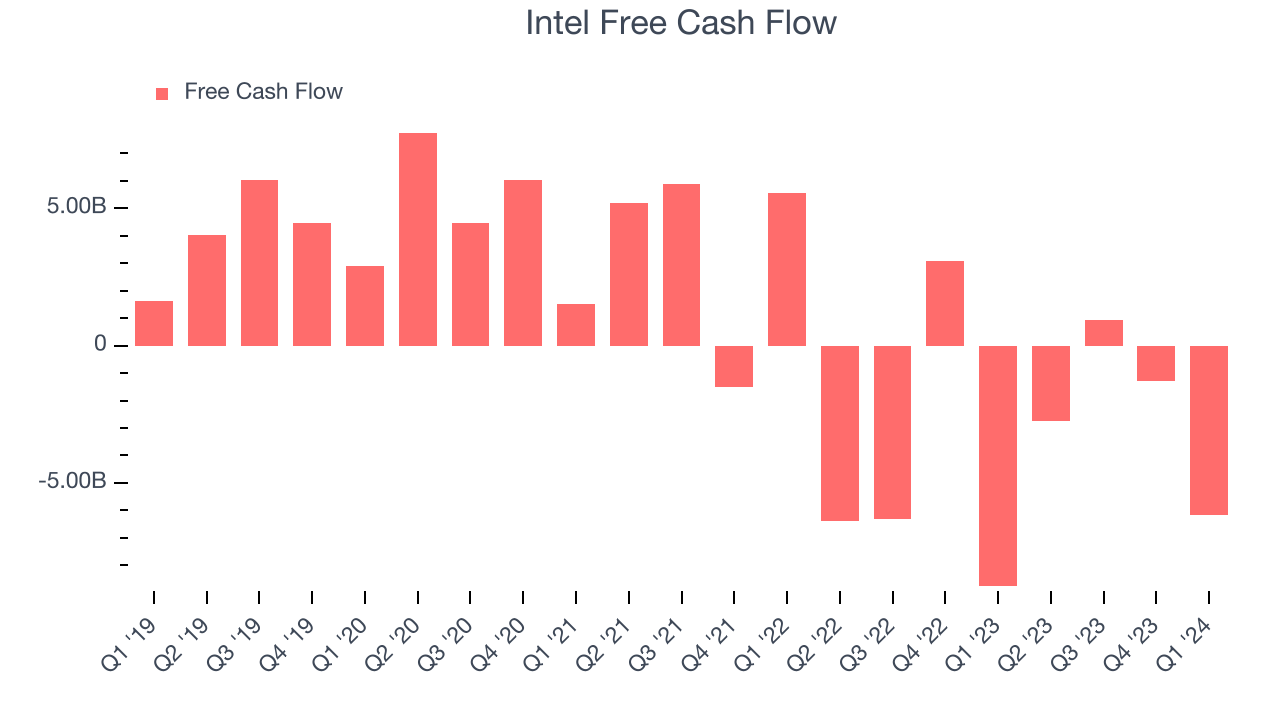
As you can see above, Intel failed to produce positive free cash flow over the last 12 months and shareholders will likely want to see an improvement in the coming quarters.
Return on Invested Capital (ROIC)
EPS and free cash flow tell us whether a company was profitable while growing revenue. But was it capital-efficient? A company’s ROIC explains this by showing how much operating profit a company makes compared to how much money the business raised (debt and equity).
Intel's five-year average ROIC was 11.6%, somewhat low compared to the best semiconductor companies that consistently pump out 35%+. Its returns suggest it historically did a subpar job investing in profitable business initiatives.
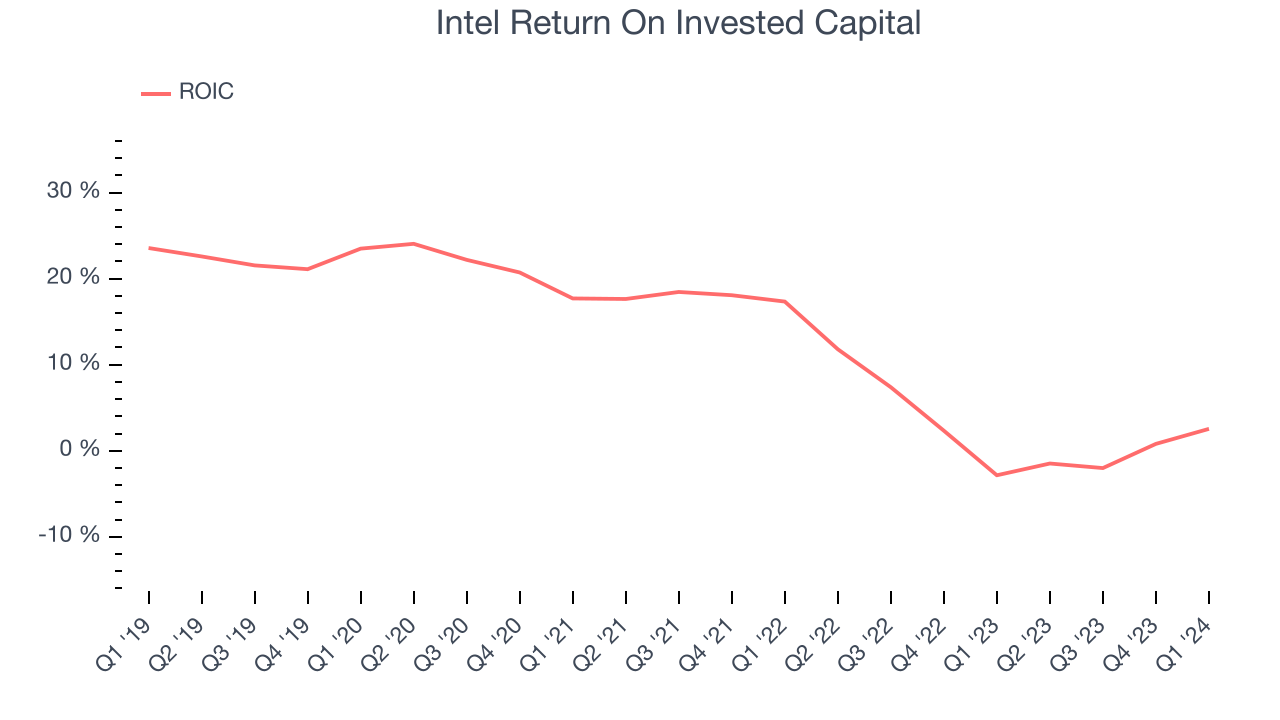
The trend in its ROIC, however, is often what surprises the market and drives the stock price. Unfortunately, Intel's ROIC significantly decreased over the last few years. Paired with its already low returns, these declines suggest the company's profitable business opportunities are few and far between.
Balance Sheet Risk
As long-term investors, the risk we care most about is the permanent loss of capital. This can happen when a company goes bankrupt or raises money from a disadvantaged position and is separate from short-term stock price volatility, which we are much less bothered by.
Key Takeaways from Intel's Q1 Results
We were impressed by Intel's strong gross margin improvement this quarter. We were also glad its operating margin improved. On the other hand, its revenue missed. Looking ahead, revenue and EPS guidance for next quarter both missed analysts' expectations by a meaningful magnitude. Overall, this was mediocre quarter for Intel. The company is down 6% on the results and currently trades at $33.05 per share.
Is Now The Time?
When considering an investment in Intel, investors should take into account its valuation and business qualities as well as what's happened in the latest quarter.
We cheer for everyone who's making the lives of others easier through technology, but in the case of Intel, we'll be cheering from the sidelines. Its revenue has declined over the last three years, and analysts expect growth to deteriorate from here. On top of that, its growth is coming at a cost of significant cash burn, and its operating margins reveal subpar cost controls compared to other semiconductor businesses.
Intel's price-to-earnings ratio based on the next 12 months is 21.7x. While we've no doubt one can find things to like about Intel, we think there are better opportunities elsewhere in the market. We don't see many reasons to get involved at the moment.
Wall Street analysts covering the company had a one-year price target of $45.21 per share right before these results (compared to the current share price of $33.05).
To get the best start with StockStory check out our most recent Stock picks, and then sign up to our earnings alerts by adding companies to your watchlist here. We typically have the quarterly earnings results analyzed within seconds of the data being released, and especially for the companies reporting pre-market, this often gives investors the chance to react to the results before the market has fully absorbed the information.
